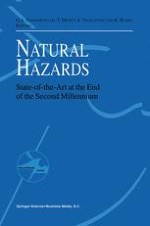2000 | OriginalPaper | Buchkapitel
Electrical Impedance Spectroscopy Used as a Tool for the Detection of Fractures in Rock Samples Exposed to either Hydrostatic or Triaxial Pressure Conditions
verfasst von : G. Nover, S. Heikamp, D. Freund
Erschienen in: Natural Hazards
Verlag: Springer Netherlands
Enthalten in: Professional Book Archive
Aktivieren Sie unsere intelligente Suche, um passende Fachinhalte oder Patente zu finden.
Wählen Sie Textabschnitte aus um mit Künstlicher Intelligenz passenden Patente zu finden. powered by
Markieren Sie Textabschnitte, um KI-gestützt weitere passende Inhalte zu finden. powered by
Pressure induced variations of the pore geometry were studied by means of complex electrical dispersion measurements on natural marble (97% calcite, 3% quartz) and synthetic calcite samples (95% calcite, 5% quartz; Siddiqi et al., 1997). Hydrostatic (up to 160 MPa) pressures were used to examine the closing of fractures, whereas, triaxial pressures (P c = 3 MPa; P u = 1 to 100 MPa) revealed information on forming and growth of cracks. Porosity data ranged from 1 to 4 vol%. Permeabilities of the synthetic samples covered the range from 0.02 to 4µD, whereas the natural marble exhibited a permeability of less than 5 nD. BET inner surface areas ranged from 0.29 to 0.7 m2/g. The frequency dispersion was measured in the frequency range 1 kHz to 1 MHz. This frequency range is extensive enough to fit model data to the measured data. The interpretation of the model data revealed information on bulk conduction processes and interfacial phenomena as well. The latter one is directly related to variations in the pore geometry and resulted in a correlation between the BET surface and the model parameter sensitive to the closing, opening, forming and growth of fractures. A significant ‘precursor’ signal before failure was found in the triaxial experiments.
